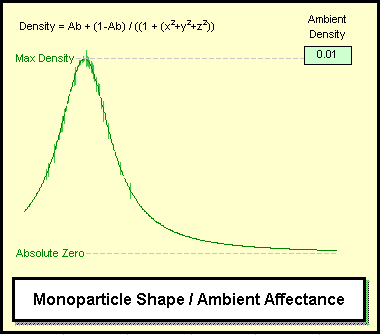And since you asked about how I derived that equation for the affectance distribution of a monoparticle shown in this video:
[youtube]https://www.youtube.com/watch?v=l6-_6__9ZvY[/youtube]
The equation is the resolve to the following necessary facts concerning a stable, stagnate congestion of a fluid substance.

Imagine a hollow sphere surrounding a particle, “sphere A”. There is affectance flow in and out of that surface sustaining the particle’s congestion and form. The total surface area represents an amount of affectance and that amount distributed over the surface area represents an affectance density, density-A.
Then imagine another smaller sphere concentric to A, “sphere B”. There is also a density of affectance associated with that surface area, density-B. The question is, “What is the relationship between the density upon the surface of A verses that of B?” The answer isn’t quite obvious.
One can begin by realizing that every bit of affectance that propagates directly toward or away from the center of the particle must travel equally through both spheres. And each spherical region will delay such affectance in accord with the density at that radius. And the delay of propagation is a direct measure of the affectance density, or the amount of affectance “at that spot”. It should be expected that the delay, and thus the density and amount of affectance, will be different at each radius.
Then it helps to realize that at every point throughout all stable, non-moving regions the propagation delay is equal for any and all directions. Whatever delay value there might be for propagating left to right must be exactly the same as the delay for propagating up to down. This is true simply because each point has its own density value, regardless of the direction of propagation (as long as there is no motion of the overall field region = stable region). And that means that the amount of affectance propagating in any one direction (at a stable point) is equal in all directions.
If the amount of affectance propagating in every direction is the same as every other direction for each point on a surface, then by knowing merely the amount of affectance propagating in any one direction, the amount for all directions at that one point is known.
We don’t know how much affectance is propagating directly in and out of the particle center, but we do know that it is the same amount passing through both surfaces, A and B. And that means that the sum of all of the affectance of the points on surface A must be equal to the sum of all of the affectance of the points of surface B. That is very significant.
Since we now know that the total amount of affectance is the same for each surface, it can only be the surface area that determines any difference in density. Thus the surface area difference between A and B is the density difference between A and B. And that is going to be true for every radius, simply due to the symmetry of the situation.
So now we have a relationship between the amount of affectance at any radius to any other radius;
$$Spherical ; Surface ; Area = 4\pi r^2$$
$$Ad_r = Ad_0 * \frac{1}{(1+4\pi r^2)}$$
And then since we know that the very center of a particle has the maximum density possible = 1, we have:
$$Ad_0 = 1$$
$$Ad_r = \frac{1}{(1+4\pi r^2)}$$
Then additionally, we can know the total affectance content of the form merely by integrating over all surfaces:
$$\int {\frac{1}{(1+4\pi r^2)}}dr \quad = \quad \frac{\sqrt{\pi}}{4} ≈ 0.443113$$
And that yields a graph;

Then if we add the concern of the particle not being the only existence, but rather a particle within an ambient affectance field, we get;
$$Ad_r = \frac{1-Ab}{(1+4\pi r^2)}$$

More philosophically, this represents a necessary power (and/or wealth) distribution in a 3D region for free flow, fluid power or wealth that is being delayed based upon complexity of decision making.
![]()


